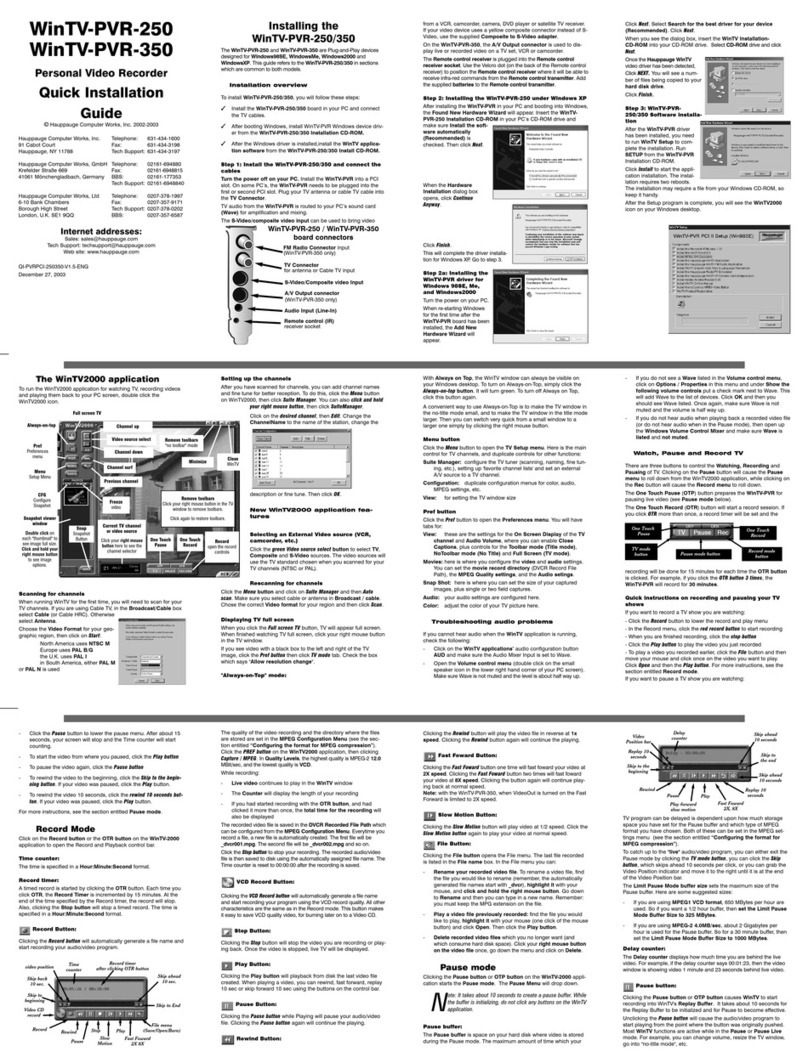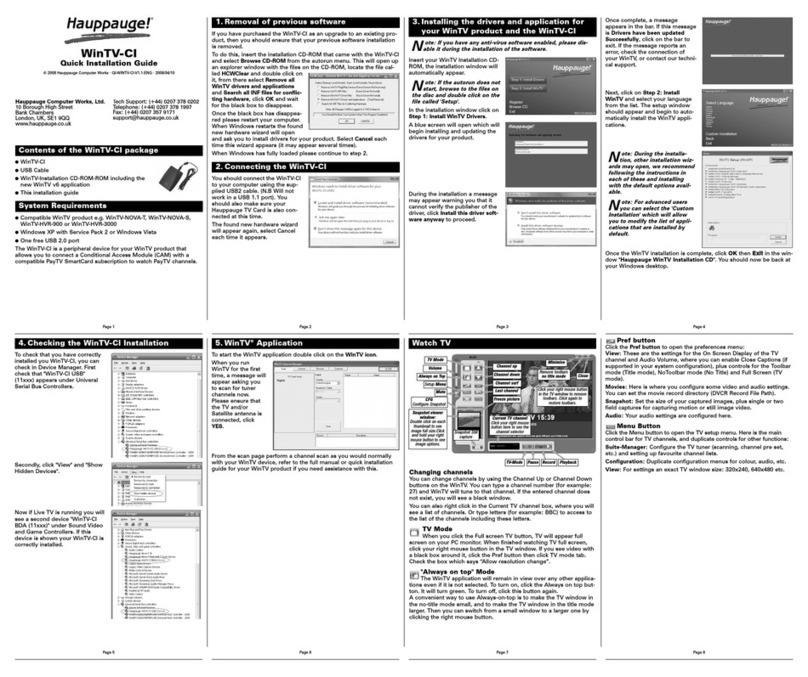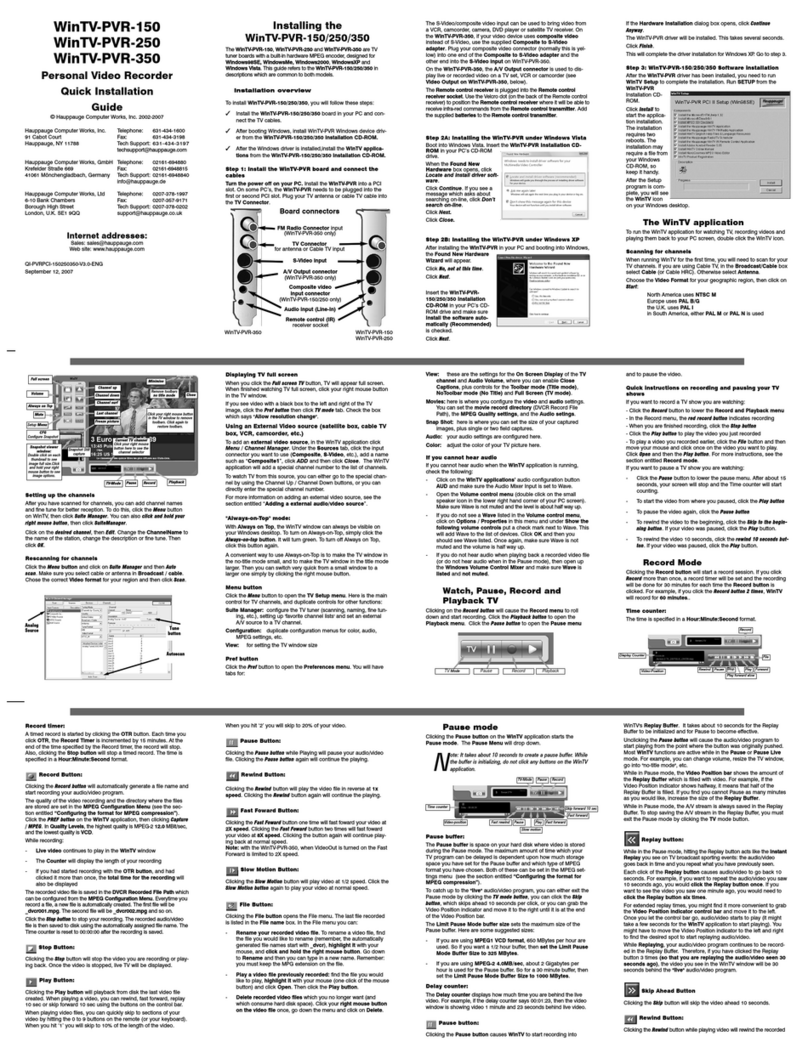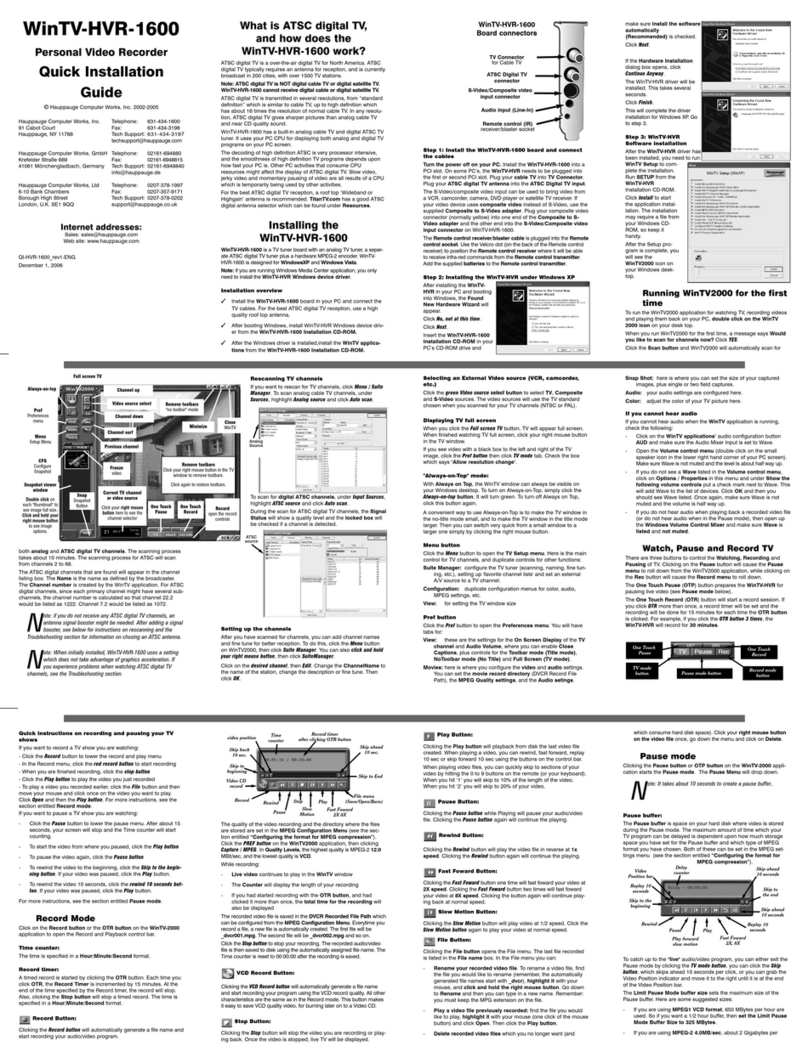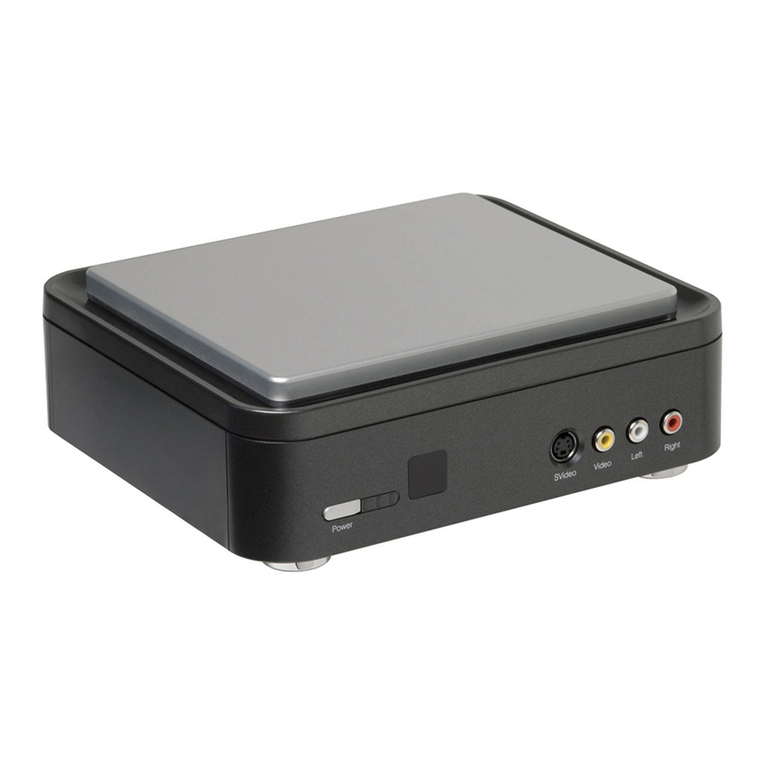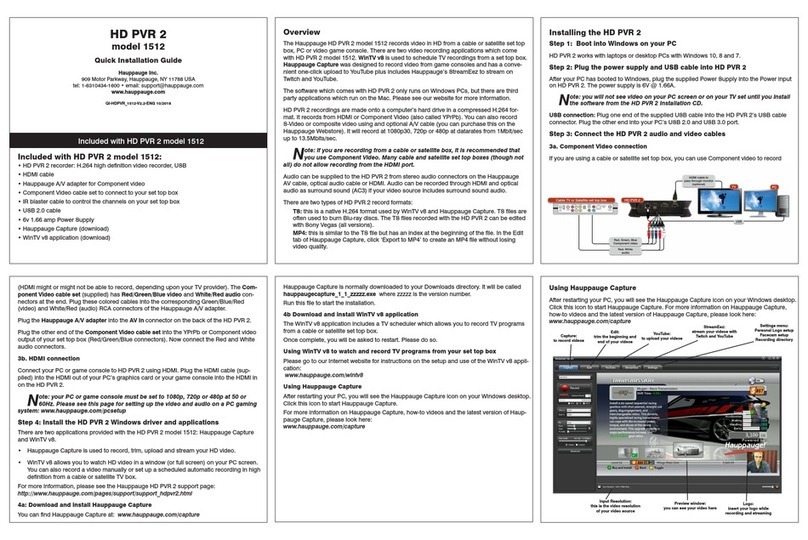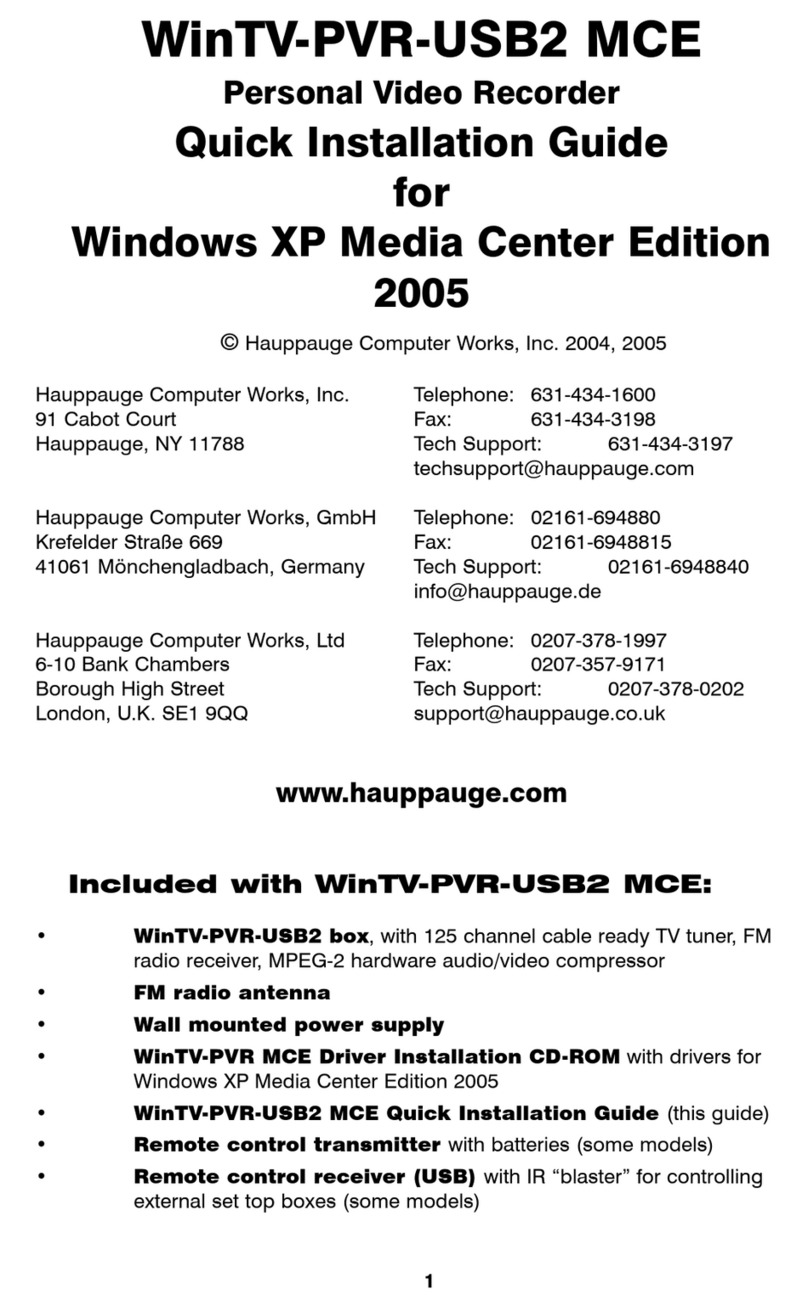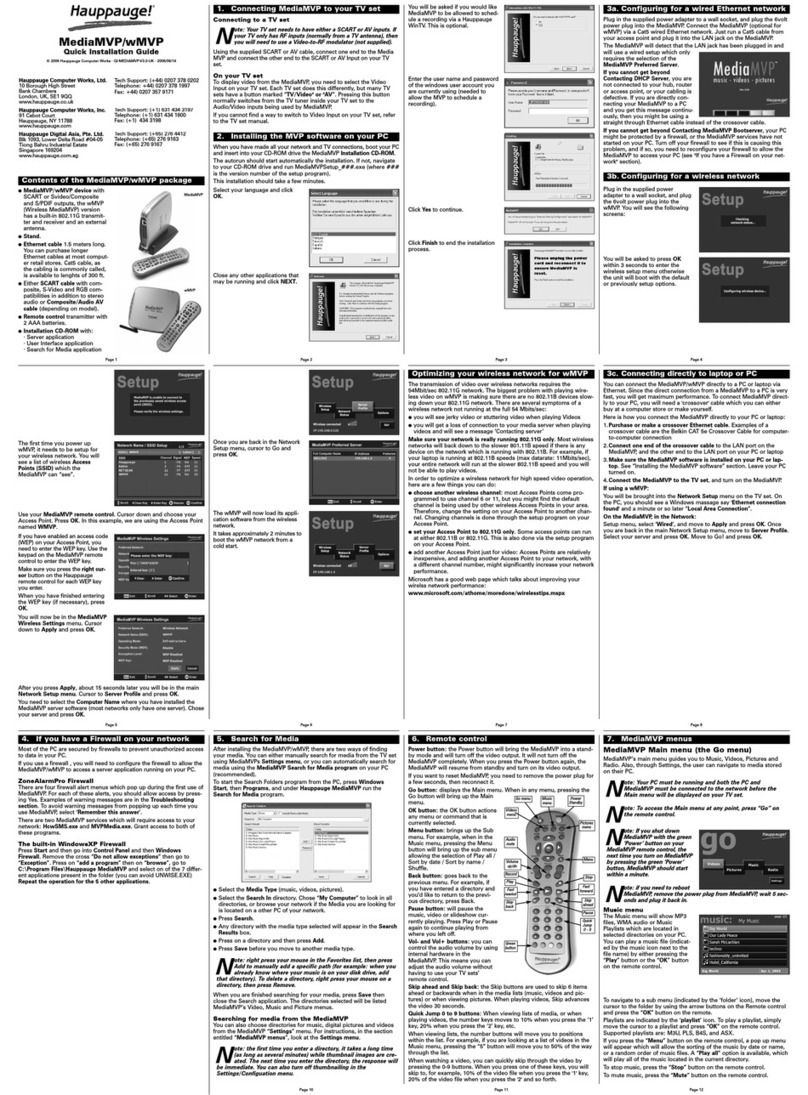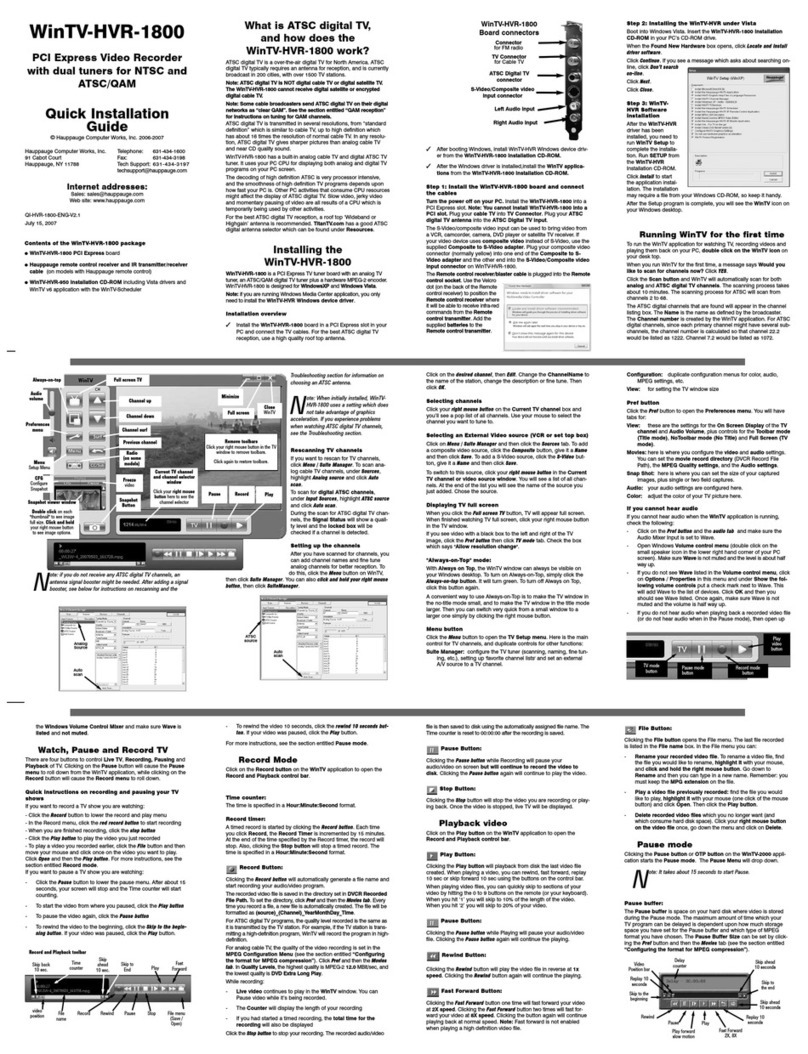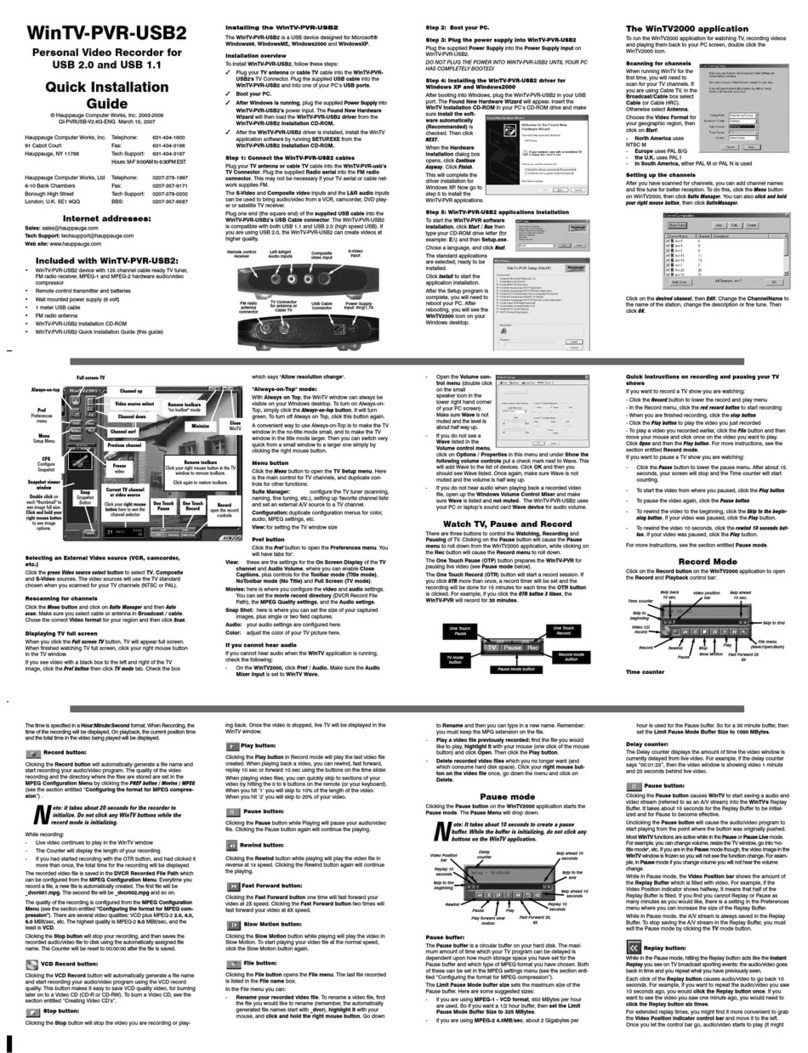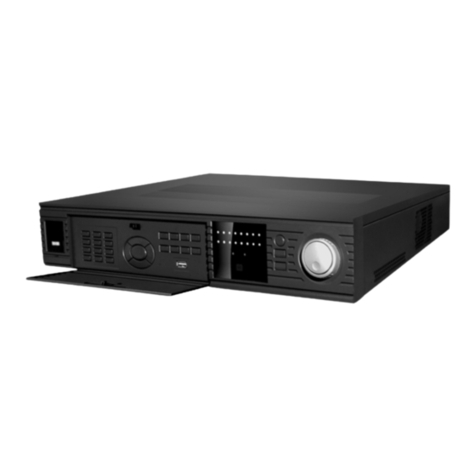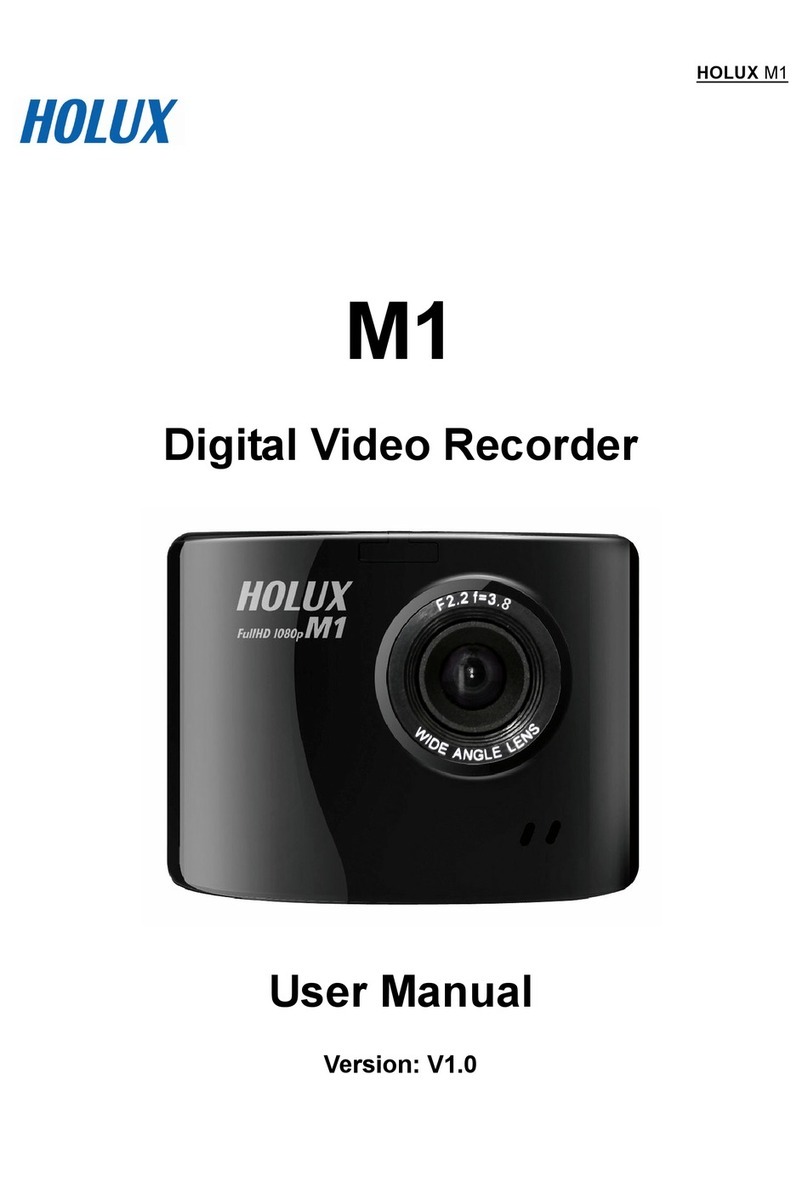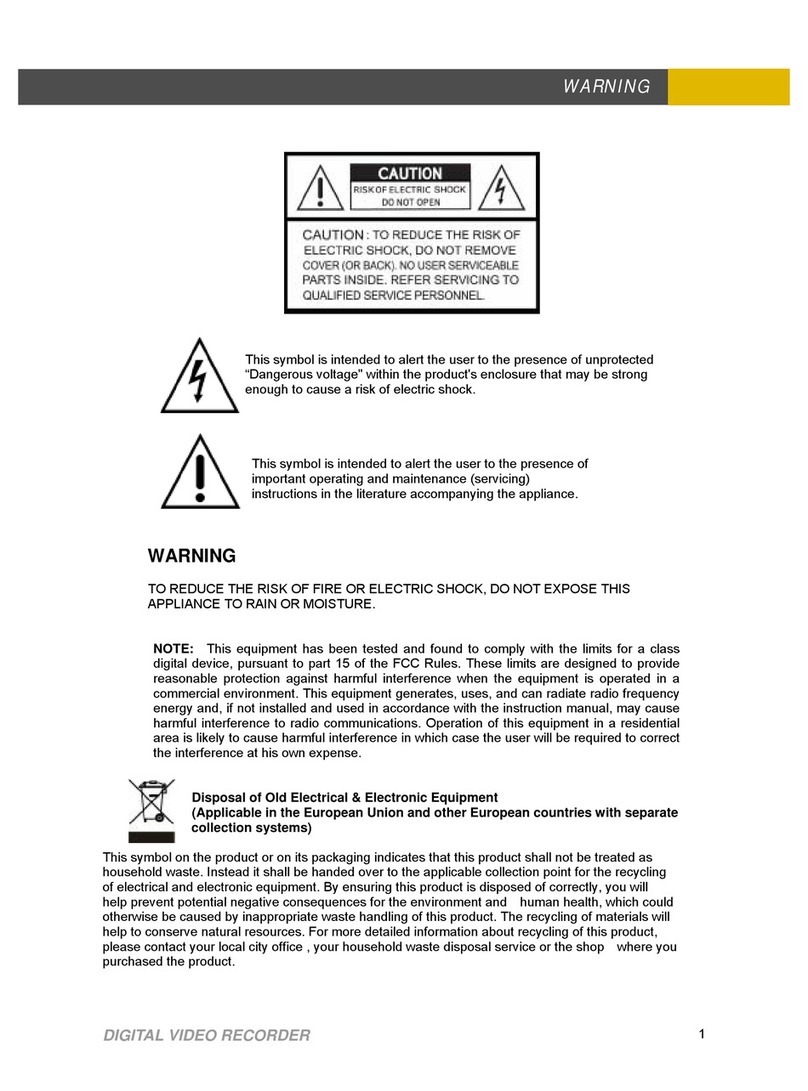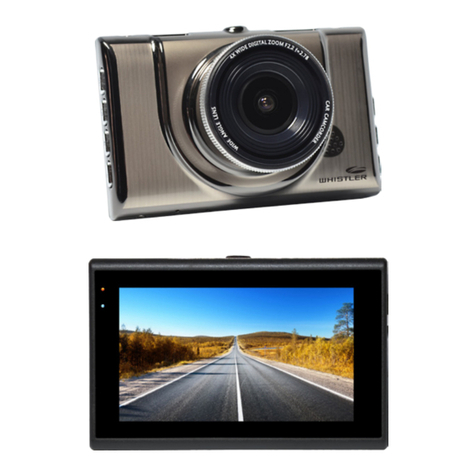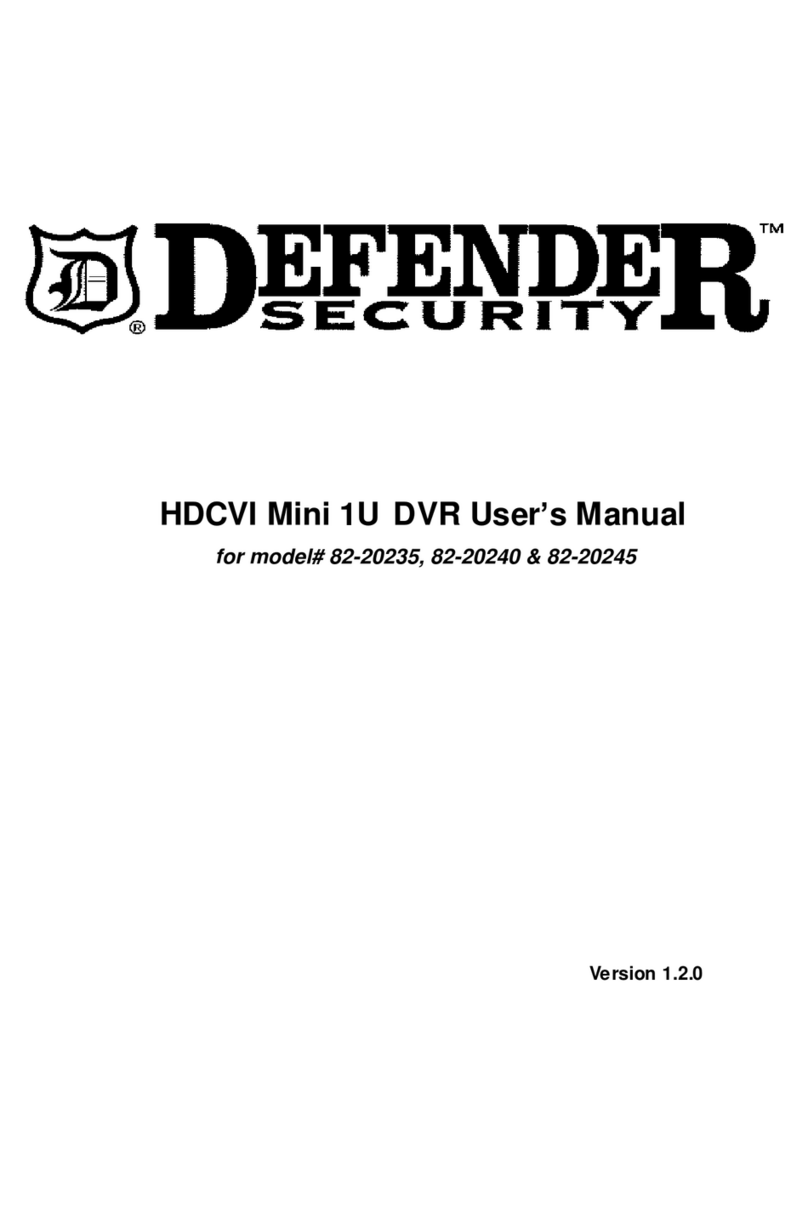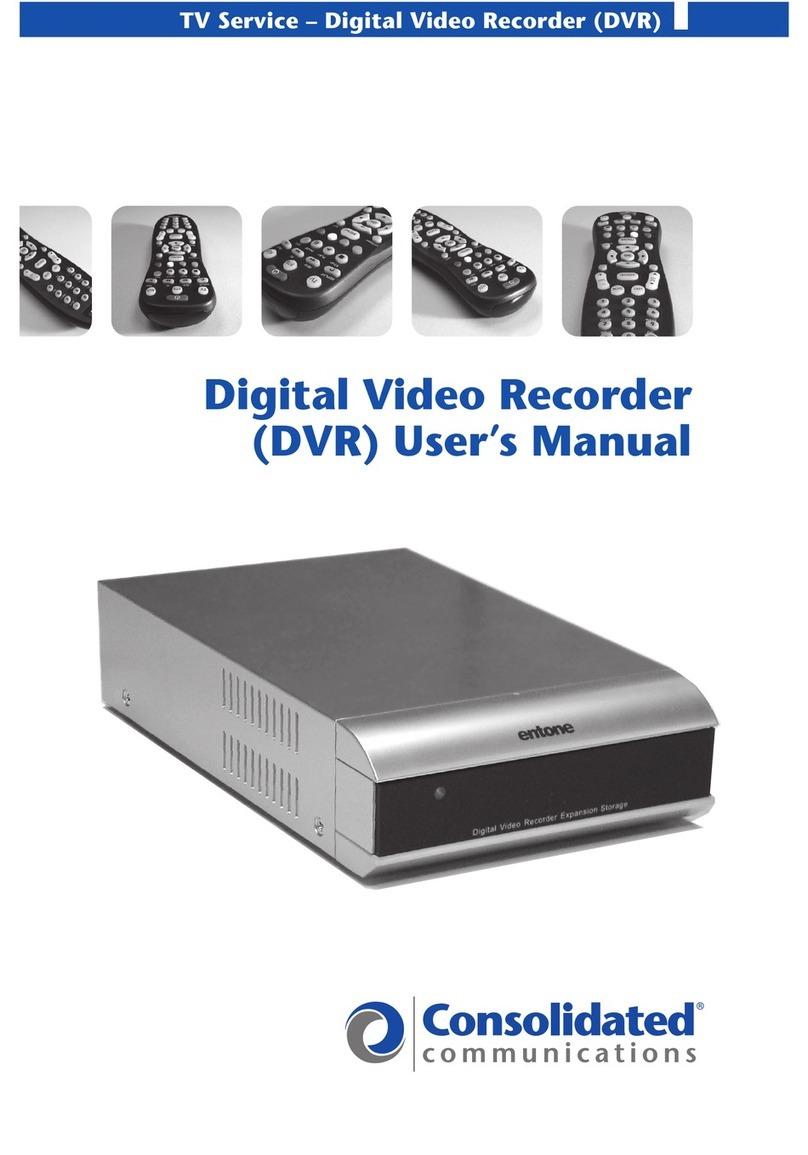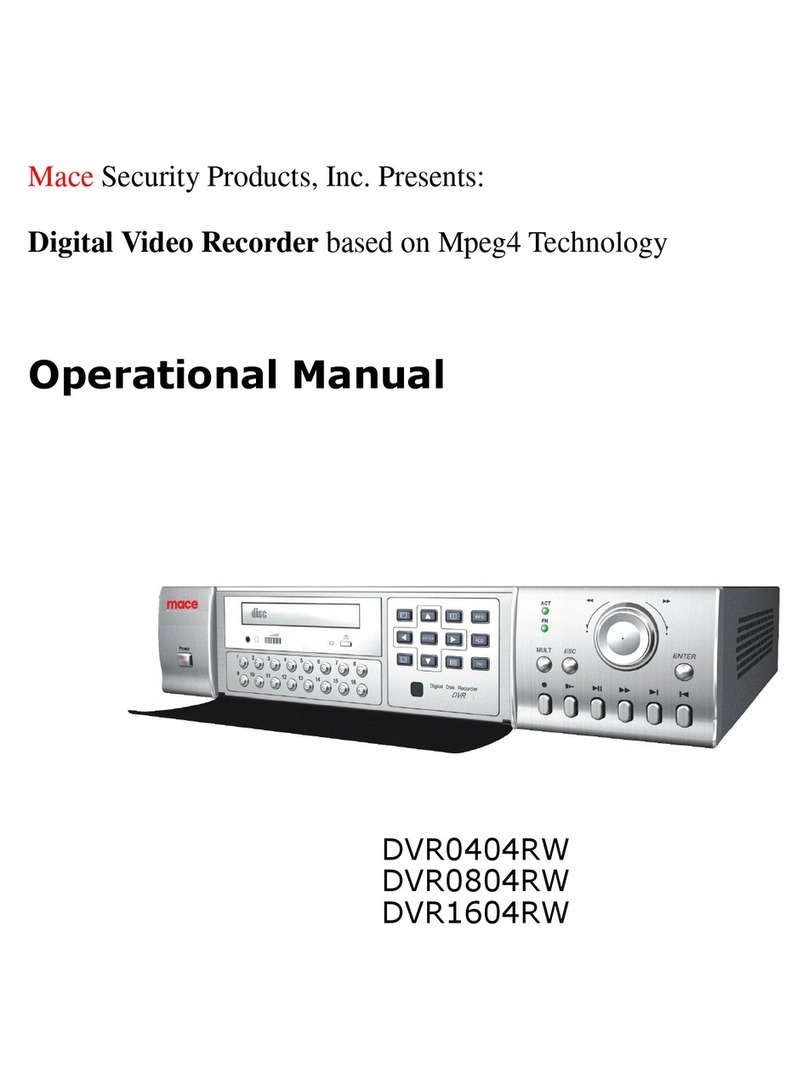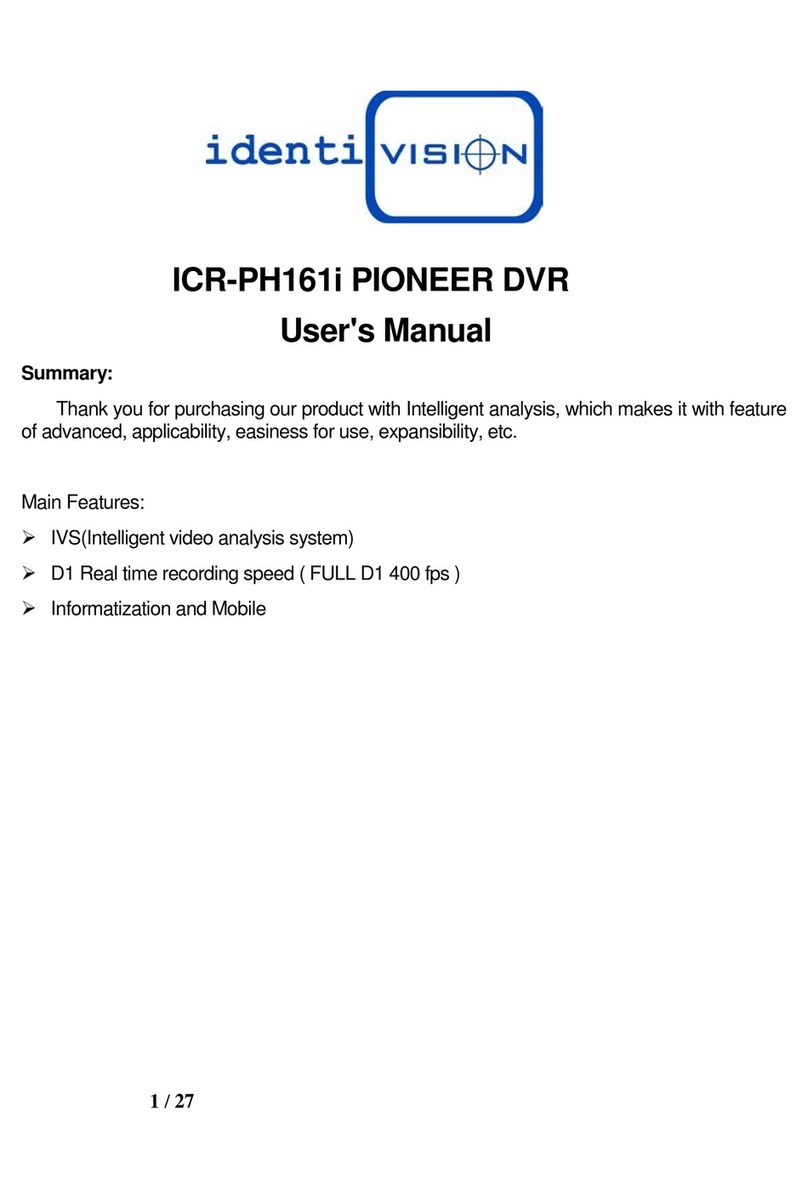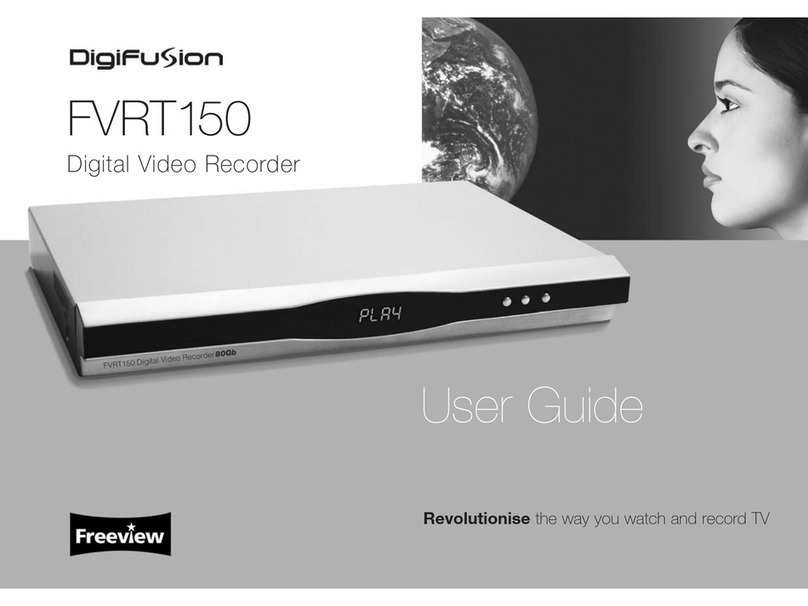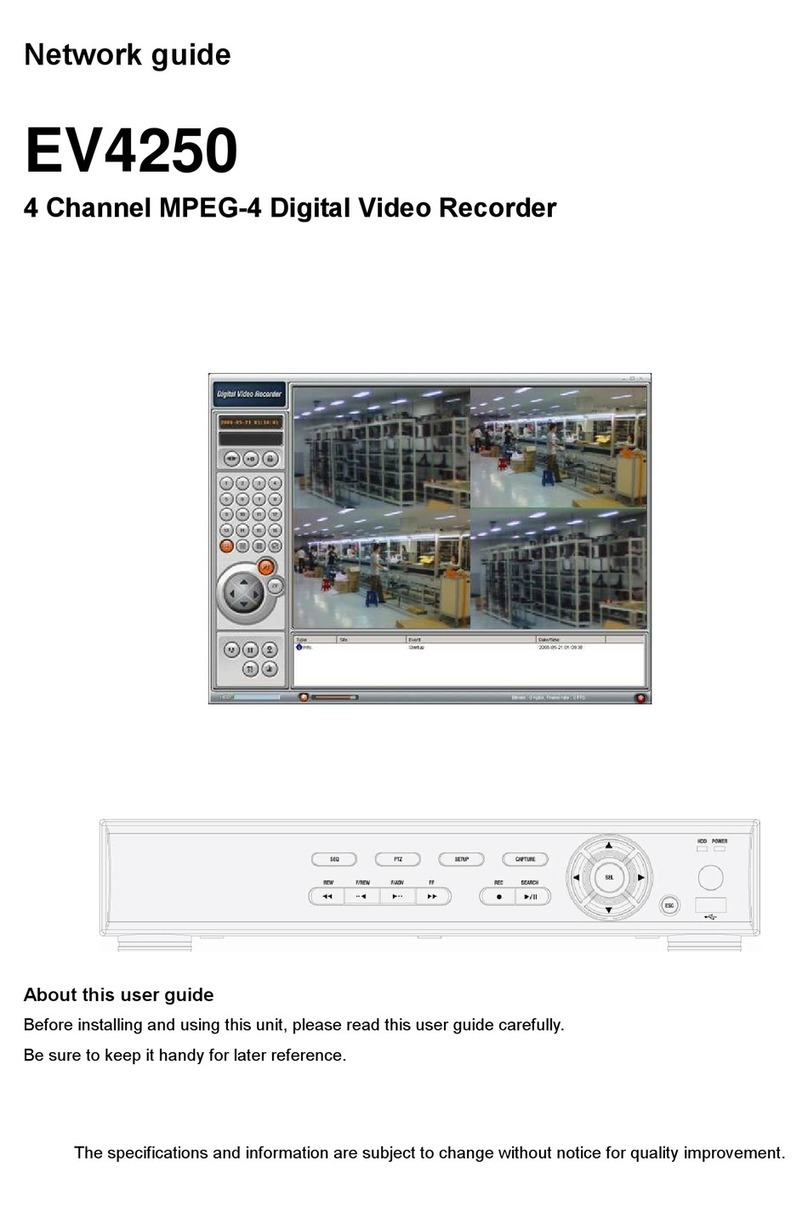Page 7 Page 8 Page 9
Page 10 Page 11 Page 12
WinTV Scheduler allows you to schedule the recording of
TV shows. WinTV Scheduler, once it is set, can be closed,
and the WinTV application will “wake up” at the desired
time and tuned to the desired channel.
When using an Electronic Program Guide (EPG) such as
TitanTV, the WinTV Scheduler makes a conversion so that
correct ATSC
digital channels
will tuned. For
example, if the
EPG wants to
record digital
channel 22.2,
you will see the
recording listed
in WinTV
Schedule as
recording
channel 1222.
After installa-
Schedule TV recordings with WinTV-
Scheduler
Note: the latest WinTV-HVR-950 software can be found at
www.hauppauge.com/pages/support/support_hvr950.htm
Some notes on system compatibility
Decoding high definition ATSC TV is very CPU intensive. A
graphics card with at least 64MBytes of memory and the
latest graphics driver from the manufacturer makes the
decoding task easier. Typically a 2.2 GHz Pentium 4 proces-
sor or equivalent with a graphics card having 64MBytes of
memory is required to properly decode ATSC digital TV on
your PC. A 1.6GHz AMD Sempro laptop computer tested in
the Hauppauge lab used 50% of the CPU for playing ATSC
640i format, and 90% of the CPU when playing ATSC 1080i,
the highest definition ATSC format.
In some cases, either a faster processor or more graphics
memory might be required. Slow or jerky video and a noisy
TV picture indicate system performance problems.
Jerky video with live ATSC digital TV
Jerky or distorted video can be caused by two things in
your PC or laptop: a slow CPU which cannot decode the
ATSC TV signal fast enough, and a graphics system which
cannot keep up with the high datarates of ATSC TV.
Many times, improving the performance of the graphics dis-
play will fix the jerky video display of ATSC digital TV. Here
are some tips on improving graphics performance:
- Use the latest graphics driver: graphics drivers are
often ‘tweaked’ to improve performance, especially the
built-in graphics on laptops. Check the Microsoft Windows
update site to download the latest graphics driver for your
computer. For Dell computers, check the Dell website for
the latest graphics driver.
- Use Hauppauge’s Primary program to optimize
graphics performance: Primary.exe is used to change
the display mode of a graphics card for TV watching. This
does not affect any other Windows program. Primary.exe is
found in the Hauppauge WinTV program group. The default
mode used by WinTV is Force
Primary. Force Primary uses
your processor to move the
digital TV image into the graph-
ics memory. It is more CPU
intensive but often fixes display
problems on some laptops.
Note: Snapshot does not
work in ‘Force Primary’
mode.
To use hardware graphics
Troubleshooting
Radio Interference Statement:
The WinTV products have been tested and found to comply with the limits for a
Class B digital device, pursuant to part 15 of the FCC Rules. These limits are
designed to provide reasonable protection against harmful interference in a resi-
dential installation. This equipment generates, uses, and can radiate radio fre-
quency energy and cause harmful interference to radio communications.
However, there is no guarantee that interference will not occur in a particular
installation. If this equipment does cause harmful interference to radio or televi-
sion reception, which can be determined by turning the equipment off and on, the
user is encouraged to try to correct the interference by one or more of the follow-
ing measures: reorient or relocate the receiving antenna,increase the separation
between the equipment and receiver, connect the equipment into an outlet on a
circuit different from that to which the receiver is connected, consult the dealer or
an experienced radio/TV technician for help.
FCC ID: H90WINTV
CE Statement: This equipment has been tested and complies with EN 55013, EN
55020 and IEC 801-3 part 3 standards.
CAUTION: Changes or modifications not expressly approved by the party respon-
sible for compliance to the FCC Rules could void the user's authority to operate
the equipment.
FCC Statement
Record and Playback menu
Recording TV
Click the Record button on the WinTV application to open
the Record control bar, automatically generate a file name
and start recording your TV program.
Clicking the Record button while recording will start an
automatic timer. Click the Record button once for 15 min-
utes, twice for 30 minutes and so on.
Configuring the record formats
When recording analog TV, WinTV uses your PC or laptops
processor and Hauppauge’s SoftPVR to make the
recording. The default recording quality is DVD. To config-
ure the directory to store video recordings and to check the
analog recording format, click the Pref button and then
Movies.
Note: since ATSC digital recording uses the format the
original TV program is broadcast in, there are no other
recording format options.
Time counter - the time is specified in a
Hour:Minute:Second format.
Stop Clicking the Stop button will stop the video you
are recording or playing back.
Play Clicking the Play button will playback from disk
the last video file created. When playing a video, you can
rewind, fast forward, replay 10 sec or skip forward 10 sec
using the buttons on the control bar.
Pause Clicking the Pause button while Playing will
pause your audio/video.
Rewind button Clicking the Rewind button will play
the video file in reverse. Clicking the Rewind button again
will continue the playing of the video.
Fast forward button Clicking the Fast Forward but-
ton one time will fast forward your video at 2X speed.
Clicking the Fast Forward button two times will fast forward
your video at 8X speed. Clicking the button again will con-
tinue playing back at normal speed.
Slow motion button Clicking the Slow Motion
tion, WinTV Scheduler can be found on your Windows
desktop. You can also find it in Start / Program files /
Hauppauge WinTV.
WinTV Scheduler works by using the Windows Task
Scheduler to launch WinTV at the chosen time. WinTV
Scheduler sets up a command line in Task Scheduler to run
WinTV, specifying a TV channel and a length of time to
record.
To set up an event for timed watching or recording, run
Scheduler and click on the Add Program. The items that
need to be set for each event are:
- Time to Begin Program: set to the desired start time.
The default time is about 3 minutes from the current time.
Click on the hour to set the hour, the minute to set the
minute and the second (if you feel this is necessary) to
set the second to start the program.
Note: It takes about 10 seconds to launch the WinTV and set up for
recording.
- Time to End Program: set to the time to end this event.
Note: you need to leave at least 30 seconds between scheduled pro-
grams to give the recorder time to set up its disk buffers.
- Program Period: one time, daily, weekly
- Date to Begin Program: today’s date is the default.
Change this if you want to schedule on another date.
- Source selection: leave at WinTV to open WinTV at the
requested time and the requested channel.
- Channel selection: choose one of the scanned channels.
- Recording options: click on Record to File to record
your show. Leave this button unchecked to watch TV at
the requested time. You can also name your file to record.
Once these are set, click Set Program. You can add more
Events, clicking Set Program after each event is set. When
you are finished click Close. The WinTV program does not
have to be running for the Schedular to work. If WinTV is
not running, it takes about 10 seconds to start Scheduler
and to start the recording of TV.
Clicking on the Record button will cause the Record
menu to roll down and start recording. Click the Playback
button to open the Playback menu.
Note: Pause is not supported on WinTV-HVR-950.
Recording TV with the WinTV-HVR-950
When recording ATSC digital TV, the recording format is
the same as the digital TV resolution of the TV program.
These recordings will consume a large amount of hard disk
space. For example, if the TV program is being transmitted
at the highest ATSC resolution, called “1080i’, the recording
will consume 5.6
Gigabytes of disk
space per hour of
recording.
When recording
analog cable TV
using SoftPVR, the
‘DVD’ MPEG-2 for-
mat will typically
consume 2.8 Gbytes
per hour.
View: For setting an exact TV window size: 320x240,
640x480 etc.
Configuring an external A/V source in WinTV using
the A/V cable (on some models)
To bring video from an external audio/video source, you will
need the WinTV-HVR-950 A/V cable.
When using an external audio/video such as a satellite TV
receiver, VCR, cable TV set top box, camcorder, game con-
sole etc, you will need to connect the S-Video input con-
nector or Composite video input connector for video
and the Audio input (Line-In) for the sound.
To configure the external A/V source, in the WinTV applica-
tion click Menu / Suite Manager and Sources. To add the
S-video or Composite source, highlight the entry and
then select the Video Format from the drop down list.
NTSC is the commonly used format in North America.
Select Add to finish. Then click Close. To select an external
audio/video source, click the Up and Down channel but-
tons to cycle through TV, Composite and S-Video sources.
The external A/V source is at the end of the channel list.
Watch and record TV
button during playback will cause the video to play in slow
motion. Clicking the Slow Motion button again will return
the video to normal playback speed.
Playback TV recordings
Click the Playback button on the WinTV application to
open the Playback control bar.
File button In the File menu you can:
●Play a video file previously recorded: Find the file you
would like to play, highlight it with your mouse (one click
of the mouse button) and click Open. Then click Play.
●Rename your recorded video file: To rename a video
file, on the video filename click once with your right
mouse button, click Rename and then type in a new
name. Remember: you must keep the MPG extension on
the file.
●Delete recorded video files which you no longer
want: Click your right mouse button on the video file
once, go down the menu and click Delete.
Play Clicking the Play button will playback from disk
the last video file created. When playing a video, you can
rewind, fast forward, replay 10 sec or skip forward 10 sec
using the buttons on the control bar.
Pause Clicking the Pause button while Playing will
pause your audio/video.
acceleration, close WinTV, then run Primary. Click Allow
VMR. Close Primary and rerun WinTV. The Allow VMR
setting will allow your graphics system to use hardware
acceleration for video decode. Note: graphics hardware
acceleration does not work on all systems.
If this setting does not help, or if you experience WinTV not
responding after a channel change, then your graphics sys-
tem cannot use hardware graphics acceleration.
In this case, run Primary. Click ‘Force Primary’ then rerun
WinTV.
Only some channels are found during ATSC
channel scan
If you are only receiving some known TV channels when
scanning, it means your TV antenna is not adequate to pick
up the channel. You will need either an antenna signal
booster (a Radio Shack antenna amplifier will work) or a
high gain antenna. Here’s a link to an ATSC antenna selector:
http://www.antennaweb.org/aw/address.aspx
Black window when selecting an ATSC channel
A black window when selecting an ATSC channel means
that the WinTV-HVR-950 is not getting a signal. This is most
often due to poor reception. See “Only some channels are
found during ATSC channel scan” above.
Uninstalling the WinTV driver and applications
Run the hcwclear.exe from the installation CD. Select OK A
black screen will briefly appear and once it has disappeared
the software will be removed. If you now re-start the comput-
er you will be at Step 4 of the installation.
Keyboard shortcuts
Sound up - Page Up
Sound down - Page Down
Plus (+) - Chanel Up
Minus (-) - Channel Down
Ctrl T - Frame TV
Ctrl P - Frame Print
Ctrl F - Still image
Ctrl+M - Mute on/off
ALT+M - Re-size TV menu
0-9 - Channel number
F1 - Launch Help
SHIFT+F1 - Online Help
Space bar - Take a Snapshot
TV Mode Pause Record Playback
Play Fast forward
Pause
Time counter
Video-position Fast rewind
Skip forward 10 sec
Skip back 10 sec

